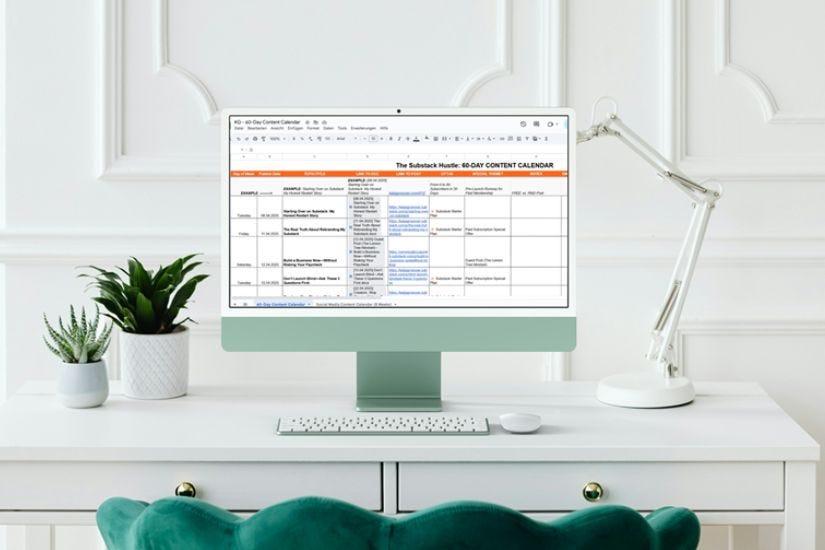Time-Saving Substack Tools for Busy Creators
Create more, stress less. These 3 simple tools help you plan, write, and grow your Substack with ease—especially when time is tight.
➡️ Grab my FREE guide: From 0 to 50 Subscribers in 30 Days – a simple, actionable roadmap to grow your Substack from scratch. Perfect for busy creators who want results without overwhelm. Download it here. 🚀
When I started my blogging journey more than six years ago, I wasn’t very organized. Writing and working online felt completely new to me, and honestly, I was overwhelmed. I spent way too much time designing my website and trying to make it look perfect—so much that I overlooked the most important part of blogging: publishing content consistently.
Yes, I wrote blog posts.
But I didn’t do it regularly, and I had no content strategy.
Most weeks, I’d realize on Friday that I needed to post something by Saturday.
As you can imagine, that kind of last-minute approach didn’t lead to my best work.
When I finally decided to take my blog seriously and treat it like a real business, I realized that content matters more than design. After all, no one would ever see my beautiful website if I wasn’t actually publishing anything.
So I started writing, publishing, and promoting my content consistently.
That’s when things began to change. Slowly but surely, more readers found my articles, started following my work, and subscribed to my newsletter. My traffic and subscriber numbers grew—but so did the pressure.
I now had to write a blog post and a newsletter every week.
And since my blog was still a side hustle, I had to become more efficient.
One lesson I’ve carried with me from our brick-and-mortar business is this: always ask how you can simplify your workflow.
So I did the same with my blog.
I started developing my own writing tools to help me stay consistent, save time, and repurpose content more effectively.
Instead of starting from scratch every time, I created templates and systems that supported me.
Over time, I refined these tools—and today, I use them to plan and grow my Substack publication, which I run alongside my German Substack.
These tools have become my go-to Substack content planning tools—designed to help me write with ease, repurpose content smartly, and publish consistently, even with limited time.
If you’re building your own Substack while juggling a full-time job or other responsibilities, I hope my tools and strategies inspire you.
Using templates doesn’t mean you’re not creative.
For me, it’s the opposite—they free up my time so I can focus on what I love most: the creative part of writing.
Tool #1: The Substack Post Template That Helps Me Write Faster
While all three tools I use are important, this one is by far the most essential to my workflow.
My Substack Post Template—originally created as a blog post template—has become the foundation of how I write every article.
Over time, I realized that writing a weekly post follows a similar process: research, SEO optimization, choosing images or stats, outlining, drafting, editing, promoting… it’s a lot.
To make this easier, I built a simple Google Doc template where I’ve collected all the steps and small details in one place.
It’s part of the Substack content planning tools I rely on every single week.
The template helps me:
Start with my user intent – What does my reader need or want from this post?
Find relevant keywords for Substack search and SEO.
Draft an outline that I can easily turn into a first “good enough” version.
Add links, sources, images, and AI-generated prompts for social media posts or Notes based on the article content.
What I love most: I can use this template on any device.
At home, I work on my laptop.
But when inspiration strikes on the go, I can just open the Google Doc on my phone and start writing.
That flexibility was especially helpful when I still worked full-time in our brick-and-mortar business.
This template doesn’t force me into a fixed format.
Instead, it acts as a checklist to keep all the moving parts—research, writing, optimization, and repurposing—organized in one place.
It’s a tool that supports my creativity, not one that limits it.
Tool #2: My 60-Day Content Calendar for Substack Creators
For a long time, I felt like I was always behind on publishing.
I had ideas, but no structure—and no plan.
That changed when I started planning my content in advance.
At first, I planned just two weeks ahead. Now I regularly plan out 12 weeks—around 60 days of content—which gives me a clear roadmap without feeling rigid.
Let me be clear: my calendar is flexible.
It’s not about locking myself into a strict schedule.
It’s about creating a clear overview of what I want to write and how it all connects.
That’s what makes this one of my favorite Substack content planning tools.
Every two months, I sit down for a one-hour session where I:
Brainstorm content ideas based on reader questions, past posts, AI prompts, and comments
Sort ideas by content pillars or current themes I want to focus on
Fill in the calendar with tentative publish dates, main topics, and content goals
Add links to published posts, the original drafts, or even the lead magnet I want to promote
Having all this in one place helps me zoom out and see the bigger picture.
I can track what I’ve published, what’s coming up, and how different posts connect.
No more digging through folders or guessing what I should write next.
This calendar has helped me stay consistent—even while running my Substack as a side hustle—and it gives me the clarity and momentum I need to keep going.
Tool #3: My Substack Metrics Tracker
One thing I started way too late in my blogging journey—but now wouldn’t go without—is tracking my post metrics.
When I launched my German Substack publication in 2023, I finally started paying closer attention to the numbers.
And honestly, I wish I had done it sooner. But no judgment—just lessons learned.
Now I spend about an hour a week (sometimes even less) reviewing my posts.
I check:
Open rates
Click-through rates
Subscriber growth
Comments and engagement
This simple routine helps me understand what’s actually working.
Because content isn’t just about what I want to write—it’s about what connects with my audience and supports them in getting results.
If a post performs well, I ask myself:
Was it the topic?
The way I framed it?
Or something else?
This kind of reflection helps me create better content moving forward.
The best part: my tracker is just a simple spreadsheet that’s connected to my Substack posts. I can access it from any device and quickly check or update details without digging through files.
This tracker has become one of my essential Substack content planning tools because it keeps me focused on progress—not perfection.
It’s a quiet reminder that even small steps matter, especially when you’re building a side hustle.
Tracking keeps me motivated and prevents burnout because I can actually see how far I’ve come.
Why These Substack Content Planning Tools Actually Work
Looking back, I wish I had these tools when I first started blogging. I could have saved so much time and energy by focusing on the right work instead of just staying busy.
Now that I use them, everything feels more focused.
I run my second Substack publication in just four hours a week—and still create more consistent content than I did when I had more time.
That’s the power of having the right systems in place.
These Substack content planning tools aren’t made for full-time marketers with big teams.
They’re designed for busy creators—people like you and me who are building something meaningful on the side of a full-time job, parenting, or other commitments.
They help you:
Stay organized without overcomplicating things
Build consistent writing habits, even with limited time
Keep visibility on your content and progress so you stay motivated
With these tools, you don’t just plan content—you create momentum.
And that’s what every side hustle needs in the beginning: momentum that helps you show up, grow your audience, and turn your publication into a real, sustainable business.
Grab the Tools & Build Your Own Weekly Workflow
I know there are mixed opinions about using templates or planning ahead—some say it kills creativity. But for me, it’s the opposite.
These Substack content planning tools help me save time and energy, especially as a solo creator.
Let’s be honest: when you’re doing everything yourself—writing, promoting, connecting, and building—you need systems that make your work easier, not harder. And if you're also working a full-time job, it's even more important to stay organized.
That’s why I believe having a simple, flexible system in place actually gives you more space for creativity.
It removes the stress and decision fatigue so you can focus on the part you enjoy most—creating content that matters.
I’m not sure how you currently plan and create your content—but whether you already have a system or are just getting started, you don’t have to do it alone.
You can develop your own templates, or you can start with mine.
I’ve put together a simple mini-course that includes all of my go-to Substack content planning tools in one place—plus a step-by-step guide to help you plan and publish content more consistently.
It’s everything I wish I had when I started.
If you're ready to simplify your workflow and grow your Substack hustle, this is a great place to start.
👉 [Check out the mini-course and grab the tools here.]
I’d love to hear how you plan your content or which tool you’re most excited to try—leave a comment or hit reply!
✨ Grow your Substack side hustle—without burnout!
These are the two resources I recommend to every creator getting started:
📘 How to Win on Substack – The go-to course for building a clear, intentional publication that attracts loyal readers.
🕓 The 4-Hour Creator: My Weekly Substack Workflow – Plan, write, and grow your Substack in one focused morning — a simple system for creators who value clarity, momentum, and time freedom.
Whether you're just starting or need a system that actually fits your life, these are the tools that make it possible.
👉 Check them out and start building your Substack with more clarity, consistency, and ease.










I'm still evolving as a writer, but 1 tool I absolutely LOVE is Trello - I started this year with scoping out 12 moths of themes and then got more specific & I now have content that I can repurpose going forward (& that's on my 2026 Trello board) x